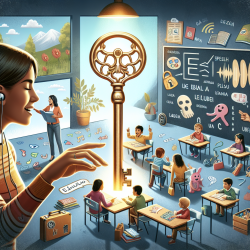Introduction
In the realm of pediatric speech therapy, the integration of cutting-edge technologies can significantly enhance the assessment and treatment of speech and language disorders. A recent study titled "A Forward Model Incorporating Elevation-Focused Transducer Properties for 3-D Full-Waveform Inversion in Ultrasound Computed Tomography" presents innovative advancements in medical imaging that can be leveraged to improve therapeutic outcomes. This blog explores the implications of these findings for speech-language pathologists and encourages further exploration into their application in pediatric therapy settings.
Understanding the Research
The study focuses on ultrasound computed tomography (USCT), an emerging imaging modality that provides high-resolution images of tissue properties. By incorporating a 3-D full-waveform inversion (FWI) approach, the research addresses limitations in traditional slice-by-slice reconstruction methods, which often result in image artifacts and inaccuracies. The novel model developed in the study accounts for the 3-D wave propagation physics and the focusing properties of elevation-focused transducers, thereby improving image quality and accuracy.
Implications for Speech Therapy
For speech-language pathologists, particularly those working with children, the ability to accurately assess anatomical structures is crucial. The advancements in USCT imaging can offer several benefits:
- Enhanced Diagnosis: High-resolution imaging allows for a more detailed examination of the vocal tract and related structures, aiding in the accurate diagnosis of speech disorders.
- Targeted Interventions: With better imaging, therapists can design more targeted intervention strategies, focusing on specific anatomical features that may contribute to speech difficulties.
- Progress Monitoring: The ability to visualize changes in tissue properties over time can help in monitoring the effectiveness of therapy and adjusting treatment plans as needed.
Encouraging Further Research
While the study provides a promising framework, further research is needed to explore its application in pediatric speech therapy. Practitioners are encouraged to collaborate with imaging specialists to investigate how these advanced techniques can be integrated into clinical practice. Key areas for future research include:
- Adapting USCT technology for use in pediatric populations, considering factors such as size and sensitivity.
- Evaluating the impact of improved imaging on therapy outcomes, including speech intelligibility and communication effectiveness.
- Developing protocols for the routine use of USCT in speech therapy assessments and interventions.
Conclusion
The integration of advanced imaging technologies, such as the 3-D FWI-based USCT model, holds great potential for enhancing pediatric speech therapy outcomes. By embracing these innovations, speech-language pathologists can improve diagnostic accuracy, tailor interventions more effectively, and ultimately contribute to better communication skills in children. As we continue to bridge the gap between research and practice, the future of speech therapy looks promising.
To read the original research paper, please follow this link: A Forward Model Incorporating Elevation-Focused Transducer Properties for 3-D Full-Waveform Inversion in Ultrasound Computed Tomography.










